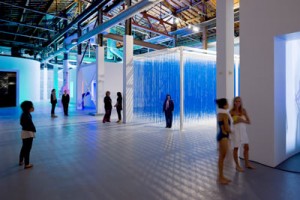MOCA exhibit takes art to new heights
Some might shy away from museums given that they can be perceived as cold and uninviting. Most are full of an extensive list of rules and regulations: no flash photography, keep a certain distance from the artwork and don’t touch anything. 
The Suprasensorial: Experiments in Light, Color and Space exhibit at the Geffen Contemporary Museum, an extension of MOCA, subverts the stereotype of dull, quiet and unwelcoming museums.
The exhibit encourages viewers to have a complete sensory experience while interacting with a psychedelic world of neon lights and interesting spaces. Acknowledging its identity as contemporary art, every piece strays from the traditional and actively engages the viewer’s interest and participation.
The exhibition features innovative Latin American artists like Jesús Rafael Soto and Lucio Montana. Its modernity and contemporary style allow the viewer to embrace each work, whether that means running through nylon cables and feeling their vibrations or walking through uniquely lit rooms.
As indicated by the exhibit’s title, Suprasensorial, one must utilize every sense to get the full experience.
In Hélio Oiticica’s and Neville D’Almeida’s progressive “Cosmococa-Programa in Progress,” viewers swim in a pool while looking at surrounding artwork and projections of John Cage’s book Notations. The artists push boundaries even further by including a modern, instrumental soundtrack and incorporating manuscripts made of cocaine, an unprecedented occurrence.
The interactivity of each work encourages viewers to think about their relationship to space.
This is particularly relevant to Julio le Parc’s “Lumiere en Mouvement” which uses a series of mirrors to transport the viewer to an ocean-like, entrancing world in which the room feels bigger than its actual size. Le Parc uses a spotlight to reflect the light and widen the space between simple materials like drywall mirrors, stainless steel and nylon.
The idealized expansion of size and transportation to a deep, mystical, oceanic world pushes the laws of physics and allows viewers to see time and space in a more fantastical, Alice in Wonderland manner.
Each piece is valuable in its own right, but one artist stands out above the rest: Carlos Cruz Diez.
When one first enters “Chromosaturación,” its meaning can be a bit perplexing. There are three large rooms colored by fluorescent lights — the first is green, followed by red then blue.
The lighting is undeniably moody and might drastically alter one’s state of mind from relaxed to passionate to depressed. The work touches on the idea of voyeurism and letting others into your emotions; a passerby can look through three windows and witness participants in each room having their complete sensorial and emotional experiences.
Though this and the other contemporary works are interesting to look at aesthetically, their messages aren’t always clear. For that purpose, guide books and documentaries featuring the artists are available for the viewers’ benefit. Diez’s documentary elaborates on his technique, describing how he systematically places two colors next to each other to form another color within a color, making his style a mathematical form of art.
The precision and thought that goes into Diez’s work makes it all the more intriguing; knowing how much effort manifests in his pieces increases the viewers’ appreciation. Diez is truly an innovative thinker, a master at his craft and an indispensable contemporary artist.
The abstract, conceptual shapes and meanings of contemporary art can be confusing, but Suprasensorial finds an excellent balance between progressive, aesthetically pleasing and understandable artwork. Given the $5 admission fee and the looming exhibit closing date of Feb. 27, you had better get in and see it while you can.
